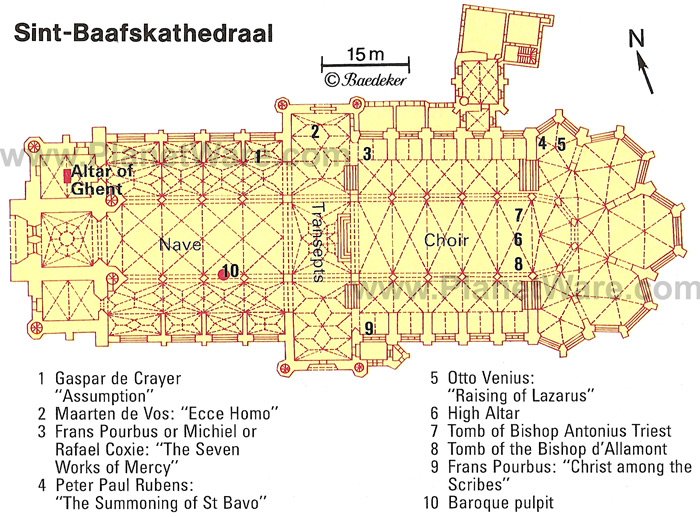Ghent is a port city in northwest Belgium, at the confluence of
the Leie and Scheldt rivers. During the Middle Ages it was a prominent
city-state. Today it’s a university town and cultural hub. Its
pedestrianized center is known for medieval landmarks such as
12th-century Gravensteen castle and the Graslei, a row of guildhalls
beside the Leie river harbor.
Cathedral of St. Bavo (Sint-Baafskathedraal)
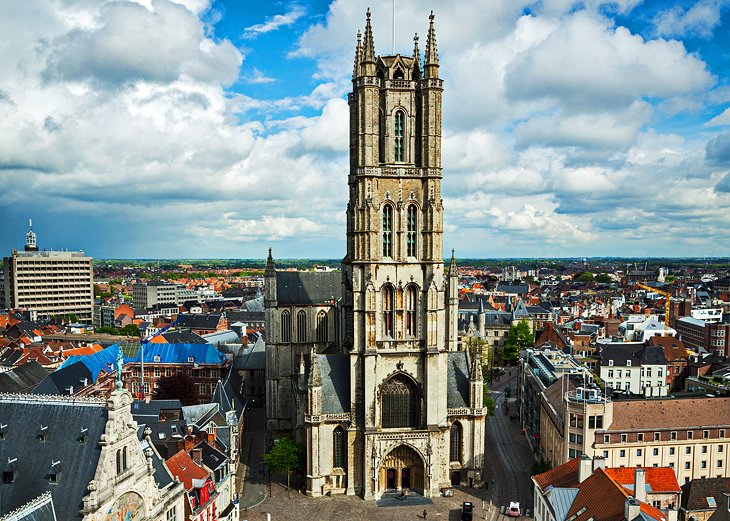
On the eastern side of Sint-Baafsplein stands the Cathedral of St.
Bavo, a majestic building of brick and granite with a Romanesque crypt
of its predecessor, Sint-Jans church. Charles V gave the cathedral its
present name after he destroyed the old one to build a fortress. The
High Gothic cathedral choir dates from the 13th century, while the late
Gothic tower and the main nave were built during the 15th and 16th
centuries. The light interior of the cathedral is richly decorated with
some unique paintings. These include The Conversion of St. Baaf by Peter Paul Rubens (1624) and Christ among the Doctors by Frans Pourbus (1571). The most famous artwork here though is The Altar of Ghent, also known as The Adoration of the Mystic Lamb,
renowned as by far the greatest masterpiece of old Flemish painting.
Below the main church, the extensive crypt contains numerous tombs of
bishops and a rich treasury. The outstanding Calvary triptych of 1464 by
Joos van Wassenhove (Justus van Gent) is also shown in one of the
chapels.
Address: Sint-Baafsplein, Central Ghent
Gravensteen
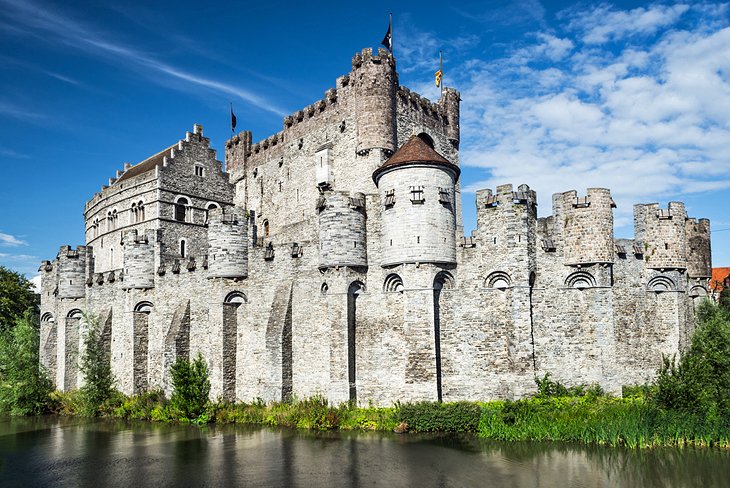
Gravensteen is one of the strongest moated fortresses in Western
Europe, surrounded by the River Lieve. It was built between 1180 and
1200 on the orders of Philip of Alsace, the former count of Flanders, on
the foundation of an earlier 9th-century structure and was created in
the style of Syrian crusader castles. Today, it remains a unique example
of the European medieval art of fortification. In the 14th-century, it
ceased to have a military function and was used by the counts for
administration of the land. In 1800, it came into private ownership and
was converted into a cotton mill and flats for the workers. In front of
the castle extends the ancient Sint-Veerleplein, possibly the
oldest square in Ghent, although the neighboring facades are of
17th-century origin at the earliest. This square was a marketplace but
also the site of executions and burnings of the victims of the
Inquisition
Address: Sint-Veerleplein 11, Ghent
The Belfry
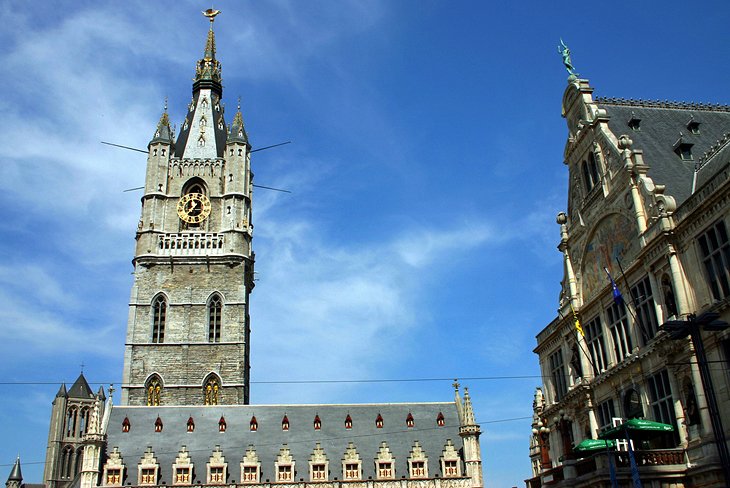
On the west side of Sint-Baafsplein stands the 91-meter-high belfry,
symbol of the city's independence, where the charters of the privileges
of Ghent were kept. The tower was begun about 1300 and by 1338, it was
mainly completed. The present-day spire was restored to its original
14th-century form at the beginning of this century and replaced the
wooden bell tower of 1380. It is crowned by a gilded copper dragon,
which was first installed in 1377. Today, it is a replica as are the
four armed figures at the corners of the platform. Only one of the
originals of these survives and can be seen on the ground floor.
The splendid Cloth Hall directly adjoins the belfry. This
building (1426-1441) by Simon van Assche was the meeting place of the
wool and cloth traders and was converted into a prison in the 18th
century. Today, it has a café-restaurant, which is popular with
tourists.
Address: Sint-Baafsplein, Central Ghent
Town Hall (Stadhuis)
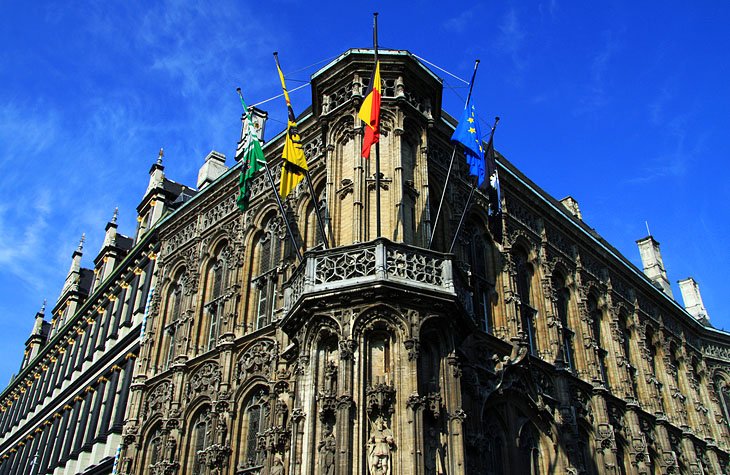
Built over a long period of time, Ghent's magnificent town hall
combines a variety of architectural styles. On the oldest parts of the
building on the Hoogpoort, completed in the style of Bruges City Hall in
1482 and containing the council chambers, the architects Rombout
Keldermans and Dominic de Waghemakere built a new wing in the finest
late Gothic form, richly decorated with statues. However, building work
on this part, which is best seen from the corner of Hoogpoort and
Belfortstraat, was suspended because of religious disputes in 1539. Only
a quarter of the original plan was realized and only the Peace Hall (Pacificatiezaal; actually the courtroom for the Keure, the protectors of the town constitution) and the Marriage Chapel,
both 1535, were built. Work only resumed at the end of the 16th
century, so that the wing facing the Botermarkt is in Renaissance style
as is the Throne Room on the upper floor.
Address: Botermarkt, Central Ghent
Old Market Area
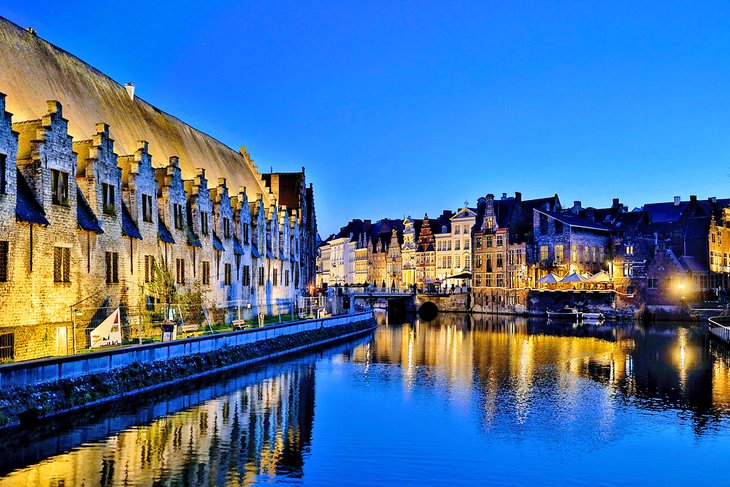
The Old Market (Groentenmarkt) began life as a fish market and then
in the 18th-century began functioning mainly as a vegetable market. In
the medieval era, Ghent's pillory stood here. On the west side of the
market area is the long Groot Vleeshuis, a medieval covered meat
market with a guild house, chapel, and numerous gables in the roof. The
building originated in 1406-1410 and was restored in 1912. At the south
end of the Vleeshuis is the Penshuizeken (entrails cottage) where
the poor were given the entrails of slaughtered animals. Today, the
Vleeshuis building is a rather fine restaurant, but even if you're not
hungry, you can walk through to view the interior.
Address: Groentenmarkt, Hoogpoort, central Ghent
Museum voor Volkskunde
Immaculately restored in 1962, this former children's hospital -
founded in 1363 - is one of Belgium's last remaining Godshuizen. These
houses were founded by well-off families for the needy. In a picturesque
courtyard are 18 typical Flemish cottages, all interconnected and now
housing the extremely comprehensive Museum voor Volkskunde, which with
its notable collection of equipment, documents, and everyday objects
provides a vivid picture of Flemish folk life around 1900. Of particular
interest are the restored workshops and living rooms, a dining room, a
barber's shop, a cobbler's workshop, an apothecary's shop, a
confectioner's bakery, and a candlestick maker's workshop.
Address: Kraanlei 65, Ghent
Ruins of Sint-Baafsabdij
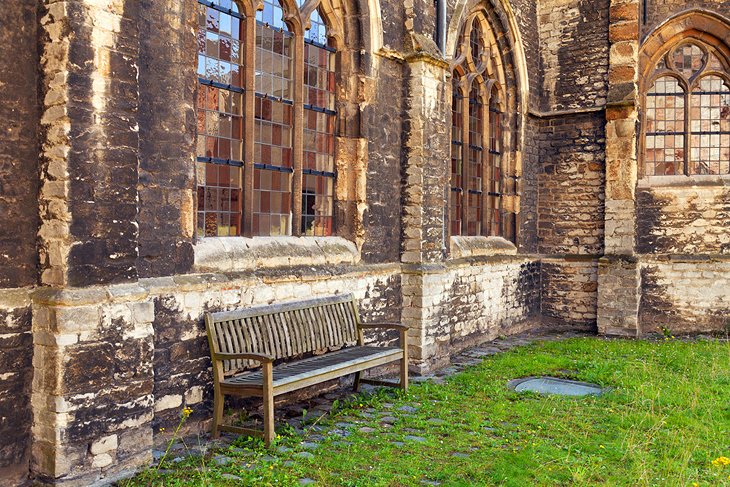
In the east part of the city, across the Slachthuisbrug over the Leie
Canal, are the ruins of Sint-Baafsabdij, an abbey founded in 630 by St.
Amandus and rebuilt after being destroyed by the Normans in the 10th
century. A gallery of the late Gothic cloisters, the octagonal
lavatorium, and parts of the chapter house and the refectory still
remain from the original abbey. The refectory, with its beautiful
12th-century Romanesque frescoes, is home to the Museum voor Stenen Voorwerpen
(Museum for Stone Cutting and Sculpture) and contains an extraordinary
collection of medieval tombstones, Ghent sculpture, and architectural
artefacts from the 12th to the 18th centuries as well as mosaics.
Address: Godshuizenlaan 2, Ghent
Museum of Ghent (STAM)
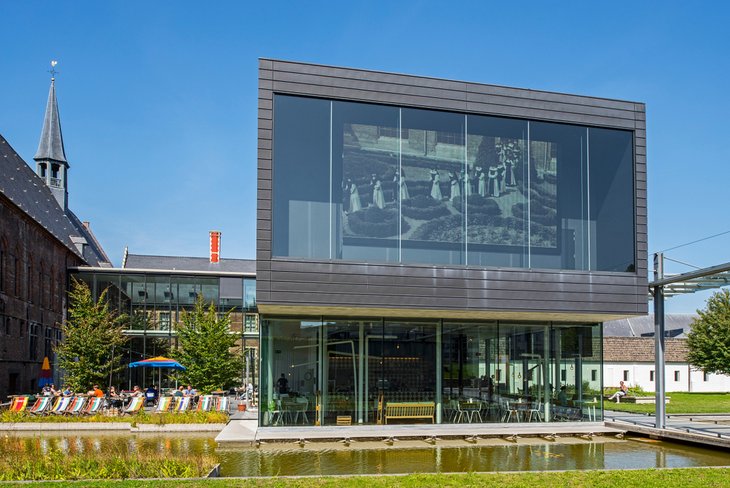
Based in the brick buildings of the Cistercian abbey of Bijloke,
the Museum of Ghent is one of the richest in Belgium and showcases a
remarkable collection that traces the heritage and culture of the city
in a unique historical setting. The numerous rooms chronologically tell
the story of Ghent with exhibits including jewelry, weapons, textiles,
books, paintings, religious icons, and ceramics all enhanced by
state-of-the-art multimedia displays. The museum's outstanding
centerpoint is the 14th-century refectory with an exceptional brick
gable. The interior walls are painted with frescoes, among which is a
10-meter-long painting of the Last Supper. As well as the permanent
collection, the museum hosts a series of temporary exhibits throughout
the year that are housed in the neighboring monastery building.
Museum of Fine Art
The main emphasis of the collection here is painting covering the
15th to 20th centuries. The central hall adjoining the entrance hall has
eight fine Brussels wall tapestries: three with motifs from the story
of Darius (17th century) and five with the theme "Triumph of the Gods"
(1717). Left of this hall are the Old Masters. Prominent are two works
by Hieronymus Bosch in Room B: Bearing of the Cross and St. Hieronymus. To the right of the Tapestry Room are paintings of the 19th and 20th centuries, especially by Belgian artists
Address: Fernand Scribedreef 1, Liemaeckereplein, Ghent
Vismarkt and Kraanlei
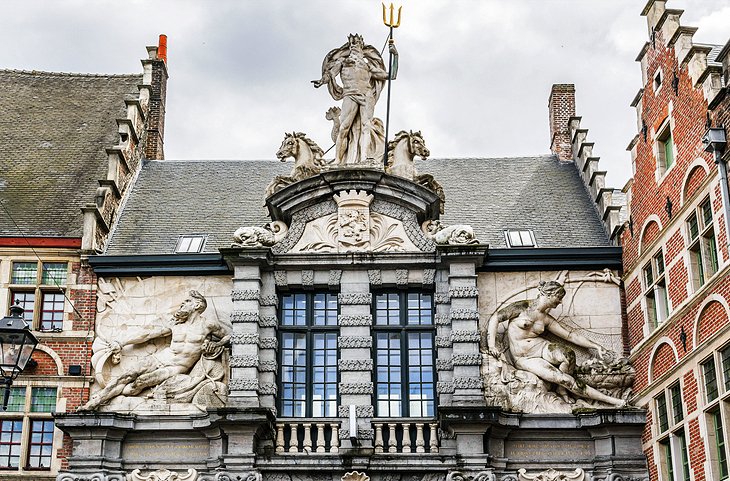
The superb Baroque building at Sint-Veerleplein No. 5 is the old fish
market, built in 1689 according to plans by Artus Quellin. The gateway
depicts Neptune and allegorical representations of the Scheldt (male)
and Leie (female). To the northeast, the Kraanlei Canal adjoins Sint-Veerleplein, all lined with elegant houses. Immediately on the left is No. 1, the Craenenburgh, then the row of houses De Lelye (No. 3-11), built around 1500 in Brabant Gothic style. No. 13, In den Bliekenmarkt is a former fish shop. Further along the Kraanlei is house No. 75, De Klok, dating from the 17th century, with a spiral staircase and decorated with numerous allegorical reliefs. No 77., De Zeven Werken van Barmhartigheid, and No. 79, Het Vliegend Hert, are Baroque 17th-century town houses, decorated with exquisite reliefs
Address: Kraanlei, central Ghent
Graslei
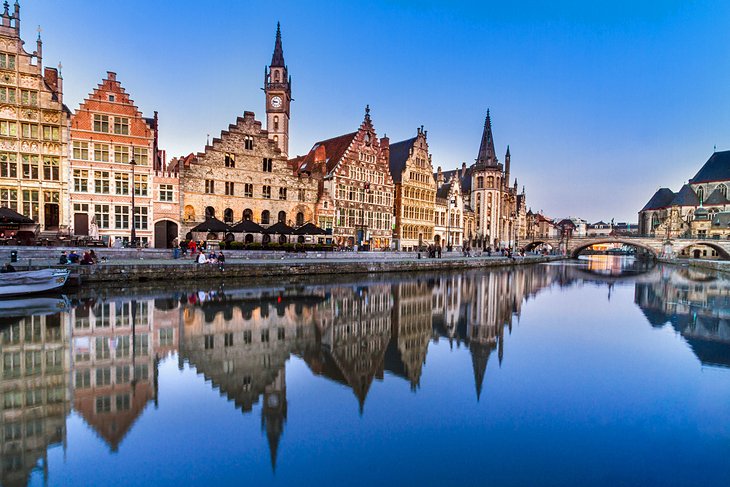
Some of Belgium's finest guild houses are along the Graslei Canal.
This is an excellent place for a stroll for anyone with more than a
passing interest in architecture. Check out the adjoining Gildehuis der Vrije Schippers (House of the Free Boatmen), built in 1531 in the Brabant Gothic style, and Gildehuis der Graanmeters (House of the Grain Weighers), with its stepped gable that dates from 1698. Further along, you'll see Tolhuisje (Customs House), a Flemish Renaissance building of 1682, which stands next to the Romanesque Spijker or Koornstapelhuis (around 1200). The Gildehuis der Metselaars (House of the Masons) from 1527 in Brabant Gothic style completes this unique row of guild houses.
Address: Graslei, Central Ghent
Korenlei
The Sint-Michielsbrug leads down to the Korenlei Canal, itself lined
by splendid facades and offering the best view of the even finer houses
on the opposite bank of the Graslei. While wandering here, take note of the following houses: No. 15 is the site of the former Hof van Gruuthuse,
(House of Duke Egmont), which dates from 1352 and is now replaced by a
building with a neoclassical facade, which also encompasses No. 17-19,
the Hotel de Ghellinck. No. 7 along the Korenlei is the Gildehuis der Onvrije Schippers
(House of the Tied Boatmen), which is a Baroque building dating from
1739. Also, pay attention to the beautiful façade of No. 24, Lintworm en Krocht. This was a Romanesque château from the 12th century that was rebuilt at the beginning of the 20th century.
Address: Korenlei, central Ghent

